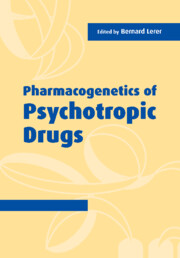Book contents
- Frontmatter
- Contents
- List of contributors
- Part I Introduction
- Part II Clinical background and research design
- Part III Molecular background
- Part IV Pharmacokinetics
- 8 Pharmacogenetics of psychotropic drug metabolism
- 9 Pharmacogenetics of chiral psychotropic drugs
- Part V Specific psychotropic drugs and disorders
- Part VI Pharmacogenetics and brain imaging
- Part VII Industry perspectives
- Index
9 - Pharmacogenetics of chiral psychotropic drugs
from Part IV - Pharmacokinetics
Published online by Cambridge University Press: 20 August 2009
- Frontmatter
- Contents
- List of contributors
- Part I Introduction
- Part II Clinical background and research design
- Part III Molecular background
- Part IV Pharmacokinetics
- 8 Pharmacogenetics of psychotropic drug metabolism
- 9 Pharmacogenetics of chiral psychotropic drugs
- Part V Specific psychotropic drugs and disorders
- Part VI Pharmacogenetics and brain imaging
- Part VII Industry perspectives
- Index
Summary
OVERVIEW
A recent editorial on metabolism and chirality in psychopharmacology stated that many investigations do not consider that many psychotropic drugs have one or more chiral centers, introducing steric factors that may make important contributions to their overall pharmacological or toxicological profile (Baker et al., 1994). Moreover, there is an increasing awareness that, besides environmental factors, genetic factors regulate the fate of drugs in the organism, and that polymorphic enzymes such as some cytochrome P-450 isozymes display stereoselectivity toward chiral substrates or in the formation of chiral metabolites from achiral parent compounds. Present knowledge about the pharmacogenetics of metabolism of psychotropic drugs is based mainly on the study of the polymorphic enzymes CYP2D6 and CYP2C19. This chapter summarizes present knowledge on the pharmacology, metabolism, pharmacokinetics, and pharmacogenetics of antidepressants, antipsychotics, and methadone.
Introduction
Numerous psychotropic drugs are chiral and have been introduced as racemates (Table 9.1). Chiral drugs are defined as having one or several asymmetric centers: at least one carbon (or sulfur) atom of their molecule has four different atoms or groups attached to it. For one asymmetric carbon atom, two enantiomers may exist and they are mirror images of each other. Sometimes, confusing terms, signs, and letters are used for their denomination. Polarized light is deviated by such a molecule and the direction of rotation is called levorotatory (−; l) (or anticlockwise) or dextrorotatory (+; d) (or clockwise).
Keywords
- Type
- Chapter
- Information
- Pharmacogenetics of Psychotropic Drugs , pp. 181 - 214Publisher: Cambridge University PressPrint publication year: 2002
- 3
- Cited by



